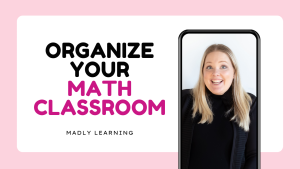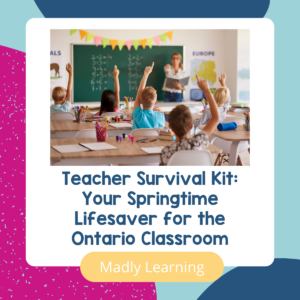When it comes to running math centers, the thought of organizing and managing the perceived chaos can be daunting. However, with effective math classroom organization strategies, you can transform your math centers into well-oiled machines. This blog post will delve into practical tips and techniques to help you organize your math classroom, ensuring smooth and seamless operations of your math centers. Discover how to streamline your classroom and create an environment where math classroom organization becomes second nature.

Organizing Math Materials
To begin, it’s crucial to establish a system for storing math center materials. Math classrooms often have various items like manipulatives, worksheets, center activities, and games that require designated spaces. Here are some tips for organizing these materials:
- Utilize Bins: Use stackable bins with attachable lids, preferably 12 by 12 craft paper bins. These bins are excellent for storing manipulatives, especially if you group them in labeled baggies or clear pencil cases. This way, students can quickly grab the specific set of manipulatives they need and return them to the appropriate bin when finished.
- Labeling: Ensure that each bin and baggie is labeled clearly. Label the front of the baggie, the box, and the lid to ensure easy identification and matching. While it may not be perfect, proper labeling will make it easier to reassemble materials and maintain organization.
- Consider the Trofast System: If you have the budget, consider investing in the Trofast system from IKEA. These versatile bins and buckets can slide out, be fully removed, and are easy to label. They provide an efficient storage solution for math materials.
Organizing Classroom Space
Organizing your physical classroom space is equally important when it comes to math classroom organization. Creating dedicated areas for math activities helps students quickly locate necessary resources. Consider the following suggestions:
- Math Wall: Designate a specific area of your classroom, whether it’s a full wall or a portion, as the math wall. This space can serve as a command center, displaying organized center activities, anchor charts, and essential math resources.
- Anchor Charts: Allocate space for anchor charts related to the current math concepts being taught. Additionally, provide an area for larger chart paper versions of anchor charts for student reference during lessons.
- Center Rotation Pocket Chart: Use a pocket chart to facilitate center rotations. The clear pockets allow for easy visibility and quick rotation of student group cards without the need for constant rearranging.
Organizing Student Materials
Effectively organizing students’ materials is crucial to maintaining a structured math classroom. Consider these math classroom organization tips:
- Notebooks or Binders: Decide whether you prefer students to use notebooks or binders for their math work. Choose the option that aligns with your teaching style and preferences. Notebooks work well for handwritten work, while binders provide flexibility for loose-leaf paper and printed pages.
- Sectional Organization: If opting for binders, consider dividing them into sections. Have sections for handouts, morning work, and student work. This arrangement ensures that students keep their materials organized and allows for easy collection and assessment.
- Hand-In Bin: Provide a designated bin or tray where students can place their completed math materials. Teach them the importance of using the designated spot consistently, reinforcing the organizational routine.
Organizing Yourself
As the teacher, it’s essential to maintain your organization to manage the math classroom effectively. Consider the following strategies:
- Use a Binder System: Create a binder system to organize your materials. Print out all necessary resources and divide them into sections. Use envelopes with zipper or Velcro closures within the binder to hold loose parts, such as task cards or cut-and-paste activities.
- Flags and Markers: Incorporate flags or markers within your binder to easily locate specific pages or lesson plans. This helps you navigate through materials efficiently and makes lesson planning smoother.
- Unit Binder: Have a unit binder prepared with all the necessary materials for each math unit. This lets you access everything easily, eliminates last-minute photocopying, and allows for efficient lesson planning.
Watch this video to learn more about these math classroom organization tips!
Want to learn more about math classroom organization?
Check out this week’s podcast episode here!

Want to hear more from Patti? Check out her blog or find her on Facebook and Instagram!
Math classroom organization is essential for the smooth operation of math centers. By implementing these organization strategies, such as using labeled bins, creating a math wall, organizing student materials, and maintaining your own organization, you’ll create an environment where math centers run like clockwork. Remember to consistently reinforce the organization systems with your students, allowing for a seamless learning experience in your math classroom.






